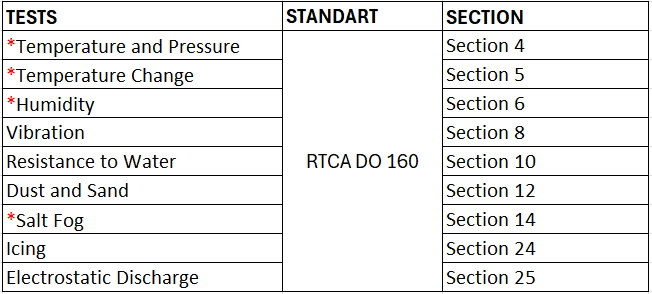RTCA DO-160
RTCA DO-160 Nedir?
RTCA DO-160 (Environmental Conditions and Test Procedures for Airborne Equipment), uçaklarda kullanılan elektrikli ve elektronik donanımların çevresel koşullara karşı dayanıklılığını belirlemek amacıyla hazırlanmış uluslararası bir standarttır.
Bu standart, havacılık sektöründe en çok kullanılan test dokümanlarından biridir ve uçak sistemlerinin güvenli, dayanıklı ve uyumlu çalışmasını garanti altına almak için uygulanır.
Kapsam:
RTCA DO-160, uçak ekipmanlarının çalışma ömrü boyunca karşılaşabileceği çevresel koşulları simüle eden testleri tanımlar.
Başlıca test kategorileri:
Sıcaklık ve Nem Testleri: Yüksek/düşük sıcaklık, hızlı sıcaklık değişimleri, nem dayanımı.
Titreşim ve Şok Testleri: Kalkış, iniş, türbülans ve motor titreşimlerinin ekipman üzerindeki etkisi.
Düşük Basınç (İrtifa) Testleri: Yüksek irtifada düşük basınca dayanım.
Yağmur, Buz ve Kum Testleri: Dış ortamda maruz kalınabilecek çevresel faktörlere karşı dayanıklılık.
Elektromanyetik Uyumluluk (EMI/EMC) Testleri: Elektronik cihazların birbirini etkilemeden çalışabilmesi.
Akustik Gürültü ve Patlayıcı Atmosfer Testleri.
Amaç:
Uçak içinde kullanılan tüm elektrik/elektronik cihazların güvenilirliğini sağlamak.
Uluslararası sertifikasyon süreçlerinde üreticiye ve kullanıcıya güvence vermek.
Standartlaştırılmış test yöntemleri ile havacılık sektöründe uyumluluk oluşturmak.
Kullanım Alanları
Uçaklarda kullanılan aviyonik sistemler
Haberleşme cihazları
Navigasyon sistemleri
Kontrol üniteleri
Motor ve güç sistemleri
RTCA DO 160 TESTLERİNDE STEST YETKİNLİKLERİ

* ile işaretlenenler TS EN ISO/IEC 17025 standardına göre akredite olarak gerçekleştirilmektedir
CONTACT BY EMAIL
[email protected]
VOICE COMMUNICATION
+90 (312) 905 06 90

STANDART KONTROL VE TEST HİZMETLERİ A.Ş.
